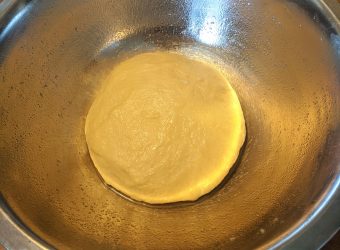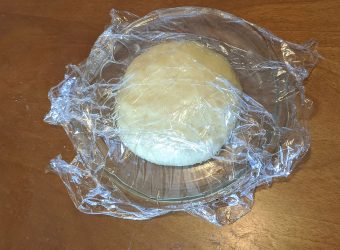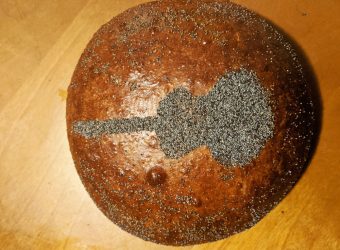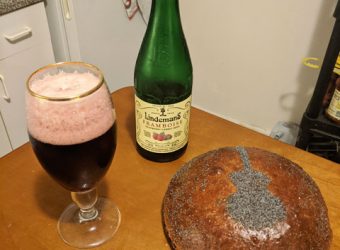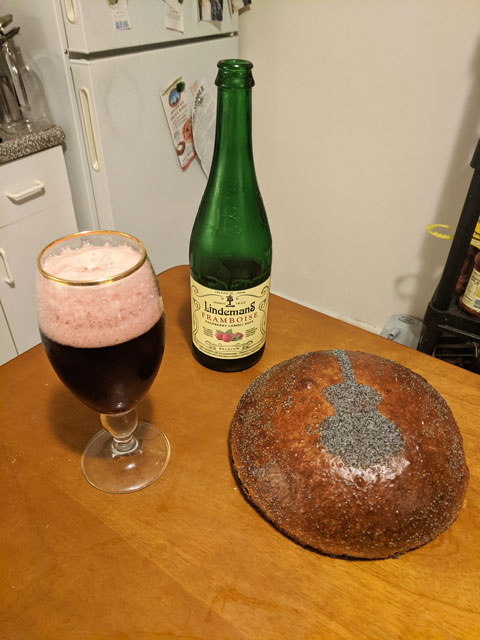 It’s my last Breedlove blog takeover! The month went by so quickly. You know what they always say, “time flies when you’re Breedlove’s Featured Artist.”
It’s my last Breedlove blog takeover! The month went by so quickly. You know what they always say, “time flies when you’re Breedlove’s Featured Artist.”
For those of you who have no idea who I am, my name is Chris Arndt. I’m Breedlove’s Featured Artist for January 2020, and I make modern alt-blues-rock with my sister, Jocelyn. Every week, as a part of my being the Featured Artist, Breedlove hands me the keys to its website and lets me write a blog where I pair one of its new Organic Collection guitars with a bread recipe (because bread is incredible) and a beer (because beer is even better!). It’s been a total blast! Thus far, I’ve made a sourdough boule in honor of the Performer Concerto, baked a Challah for the Signature Concert and mixed up a soda bread to go with the Wildwood Companion. There’s only one series in the Organics Collection left to cover—the Artista Series.
You really can’t go wrong with any of the guitars in this luxury series. They’re all absolutely top-notch. I’m going to focus specifically on the Artista Concertina Natural Shadow CE.
The quick breakdown:
-Torrefied European spruce top
-Hard Rock maple neck
-Myrtlewood back and sides
-African ebony fretboard and bridge
-Concertina body shape
-Natural Shadow Burst high gloss finish
-18 frets
I know I say this every week, but these guitars are truly special. Don’t believe me? Take a listen. There’s just something about myrtlewood—it makes guitars sound like coming home after a hard day at work, or like freshly baked cookies, or like all sorts of other ridiculously cheesy, weird similes with pretty unclear meanings for sound. I don’t know how to explain it. It truly makes these instruments magical. I recently discovered that you can sort guitars on the Breedlove website by tonewood, and I went way down the rabbit hole on myrtlewood. They’re all so awesome. And the Artista Concertina combines that rich sound with the super convenient Concertina body type—and the financial and ethical benefits of an Organic Collection instrument!
For the bread this week, I wanted to do something truly special, too. It’s my last turn as the January feature, and it’s the Artista series—I can’t half-ass this one. After doing a bunch of research and testing a few recipes, I decided to go with Massa Sovada, a Portuguese sweet bread that’s usually reserved for special occasions. It’s absolutely delicious, and in the Breedlove spirit, it combines simplicity and elegance with sophistication and truly delicious carbs.
To make this bread, you’re going to need:
-milk
-unsalted butter
-sugar
-salt
-all purpose flour
-yeast (instant is my fave, but you can use other kinds; just do the right conversion)
-lemon
-eggs
-vanilla extract
-poppy seeds (for decoration)
-vegetable oil (for greasing the pan and bowl; you can use butter if you don’t have vegetable oil)
-a kitchen scale
-an instant-read thermometer
-some common kitchen tools: a few bowls, a whisk, a sauce or sauté pan, a pie pan or baking sheet and measuring spoons
Once again, credit where credit is due: this recipe is less a fully original creation than it is an adaptation of the King Arthur Flour recipe for the same bread. I just tweaked the ratios to make it a little bit fluffier and stronger in flavor. And I added poppy seeds, because poppy seeds are the best. If you find that you like baking bread, I highly recommend checking out the King Arthur website. It’s got a huge variety of recipes, and their help line is very active and informative.
On to the recipe. First things first: get your dry ingredients together. In a large bowl, whisk together the zest of a lemon, 400g flour and two teaspoons of instant yeast (or equivalent amount of whatever yeast you choose). Into a smaller bowl, crack two eggs and one egg yolk, reserving the white. Measure two tsp of vanilla extract (the real stuff is worth the price over the fake stuff!) into the egg bowl.
Into your pan, measure 200g milk, 65g butter, 70g sugar and one- and a heaping half-tsp salt. Place it on a burner on low, and stir intermittently until it reaches 100F. This should only take a minute or two. Stir the pan one last time so no un-dissolved sugar sticks to the bottom, and pour the milk mixture into the dry ingredients with one hand, using the other to mix it in. Once the pan is empty, pour the bowl with the eggs and vanilla extract in. The milk doesn’t need to be fully incorporated; just get it all into the bowl and mix it together. Once it’s homogenous, knead it until it comes together and forms a smooth dough. It will start off ridiculously sticky, just keep going. It took me 14 minutes of kneading to get it to fully come together. Listen to The Daily or Stairway to Heaven or something. Just try not to think about how your forearm feels 12 minutes in.
Once it’s fully kneaded, place the dough in a greased bowl and cover it with something like a Tupperware lid or plastic wrap, so air can’t get through. Leave it until it’s just about doubled in size. Depending on the temperature of your kitchen, this can take between two and five hours. If it doesn’t seem like it’s doing anything, try placing it in the oven with the light on and the door cracked and give it an hour. As long as the yeast aren’t dead, it’ll go. It just needs time.
After it’s risen, grease a pie pan (or cake pan or baking sheet—whatever you want to use). Gently punch the dough down and make it into a round. Place the round on the prepared vessel. Tent it lightly with greased plastic wrap and let it proof for another couple hours, until it gets puffy looking and fills up the pan. Preheat the oven to 340F about 90 minutes after you shape the loaf. Whisk the reserved egg white with a tablespoon of cold water and glaze the proofed loaf. Then, sprinkle poppy seeds on top in a pretty-looking pattern! I’m doing a guitar, because why not?
Place the loaf in the center of the oven with a cookie sheet on the rack immediately below it. Once it’s browned, tent it with aluminum foil and bake until the internal temp is 190F. I made this recipe twice, and both times it took about 18 minutes to brown and just under 30 minutes beyond that to reach temperature. Check it fairly regularly, ovens vary a lot.
Once it’s baked, take it out, let it cool for a couple hours and enjoy! It goes really well with butter, honey and fresh fruit. Or anything, really. It’s a super delicious bread.
There you have it! A poorly decorated but very delicious Massa Sovada to enjoy as you play your Breedlove Artista Concertina. For beer, I’m going with a Lindemans Lambic. I was looking for the Cassis (that’s their black currant beer), but I went to the beer store on Tuesday and they get their weekly Lindeman’s shipment on Wednesday, so they were low on stock. That said, the raspberry flavored Framboise is still an excellent beer, and it goes perfectly with the Massa Sovada! It’s pretty sweet and light, but has enough tartness to act as a nice palate cleanser between bites.
So, I guess that’s it! Four weeks, four blogs about Breedlove guitars, bread and beer; and one Featured Artist tenure is just about up. It’s been a really amazing experience—if you liked these blogs, or our music, make sure you keep up with my sister and I after January passes! I’ll still be baking and drinking, and we’ll still be playing all over the place. Until then, cut a slice, crack a cold one and read about the Breedlove difference!
